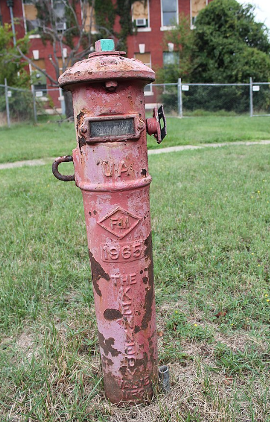Competency F2: Commission and Service Water Services and Distribution Systems
Learning Task 1
Describe the testing of water service and distribution systems
Water service pipes are vital components of any water supply system, responsible for delivering clean and reliable water to residential, commercial, and industrial buildings. Ensuring the functionality, efficiency, and reliability of these pipes is crucial to maintain a sustainable water distribution network. Testing water service pipes during installation, maintenance, or troubleshooting processes plays an important role in identifying potential issues, verifying compliance with regulatory standards, and delivering optimal performance.
Safe Work Practices
Pressure testing can be a dangerous task. Implementing and following safe work practices is needed to minimize accidents, injuries, and fatalities in the construction industry. Always follow safe work practices, use the proper PPE, and refuse any work you believe to be unsafe
Types
Pressure testing is used to evaluate the strength and integrity of water service pipes. It involves pressurizing the system with water or air to a specified pressure level and monitoring for any pressure drops that could indicate leaks or weak points. Testing helps identify potential issues before the system is put into operation and can help reduce future failures and costly repairs.
Hydrostatic
Hydrostatic testing is a common method used to assess the integrity and strength of water service pipes.
Before conducting the test, make sure that the water service pipes are properly installed and securely connected. The pipes should be clean and free from any debris that could obstruct the flow or affect the accuracy of the test.
The section of the water service pipe that needs to be tested should be isolated from the rest of the water supply system. This is done by closing valves or using temporary plugs to prevent water from flowing in or out of the test section.
The isolated section of the water service pipe is filled with water. Slowly introduce water into the system through a temporary connection or by using existing connections and once the pipes are filled, a pump or other pressurization equipment is used to increase the pressure inside the pipes. The pressure is raised to a level specified by the AHJ or industry standards. Common pressure levels for testing residential water service pipes are around 100 psi to150 psi.
After reaching the desired pressure allow the pipes to stabilize During this time, the pressure should be monitored to ensure it remains constant. This allows the pipes to be inspected for any leaks or visible signs of stress.
A visual inspection is performed to check for any signs of leakage, such as water dripping or spraying from the pipes, joints, or fittings. Additionally, any noticeable changes in pressure or visible deformities in the pipes may indicate a problem.
If there are no leaks or other issues observed during the stabilization period, the pipes are considered to have passed the hydrostatic test. However, if leaks or failures are detected, repairs or further investigation may be required to rectify the problems before the system can be returned to service.
Compressed Gas
Similar to hydrostatic testing, using compressed gas, usually air, to assess the system’s strength is another reliable method. Compressed gas can be a cost-effective alternative to water pressure testing since air is readily available and eliminates the need for water supply during the testing process. This method can save costs associated with water usage, especially in areas where water availability or disposal can be a challenge It is generally quicker than water pressure testing. It allows for rapid pressurization and stabilization of the system, reducing the overall testing time This efficiency is beneficial for construction projects where time is critical and delays need to be minimized. By using compressed gas, water service pipes can be tested in a dry state, mitigating potential risks associated with water leaks or damage This aspect is advantageous when testing pipes in colder climates, where water freezing can cause complications during traditional water pressure testing.
Before conducting the test, it is important to check that the water service pipe is compatible with compressed gas. The pipe material, joints, and connections should be able to withstand the pressure exerted by the compressed gas. Inspect the water service pipe for any visible defects, ensuring that it is properly installed and connected. Confirm that all valves, fittings, and joints are securely tightened. Clear the pipe of any debris or obstructions that may affect the test.
Connect the compressed gas source, usually an air compressor, to the water service pipe and check for an airtight seal. Gradually increase the gas pressure to the desired level while closely monitoring the pressure gauge Allow the system to stabilize for a specific duration to confirm the pipe is holding. After the stabilization period, visually inspect the pipe and its connections for any signs of leaks, such as bubbling or hissing sounds. Conduct a thorough examination of the entire system, including joints, fittings, valves, and any exposed sections of the pipe Use appropriate leak detection equipment, such as soapy water or gas leak detectors, to identify the leaks.
Tools and Equipment
Several tools and pieces of equipment will be used to perform a pressure test and subsequent inspection of the water service piping.
Gauges
Pressure gauges are used to measure and monitor the pressure levels within the water service piping system. They help ensure that the pressure is within the required range and assist in detecting any anomalies or pressure drops that may indicate leaks or other issues.
Pumps
As discussed above, when hydrostatic tests are performed, a pump (Figure 1) can be used to increase the pressure in the piping to a desired level. The pump is connected often to a hose bibb or drain and water in pumped into the already full piping to increase the pressure Both manual and powered pumps can be used depending on the required pressure.

Compressor
When performing a compressed gas test, a compressor is used to increase the pressure in the piping system. The compressor is connected to an existing or temporary valve in the piping and compressed air is introduced until the required pressure is reached. Compressors will generally require an electrical energy source but can use fuel to power their motors if no electricity is available.
Codes and Regulations
AHJ
Water service pipes must comply with specific regulatory standards to ensure water quality, health, and safety for consumers. Testing is necessary to verify that the materials, design, and installation meet the required standards and guidelines. Before working on water service lines, you will be required to contact the local authorities for permission and instruction.
Components
Water meters, isolation valves, cross connection devices, check valves, expansion devices, pumps, post indicator valves, and fire hydrants are all components found in water service piping systems.
Water Meters
A water meter is a device used to measure the volume of water consumed by a residential, commercial, or industrial property. It is typically installed at the point where the water service line enters the building or property. The primary purpose of a water meter is to accurately record the amount of water used, which is essential for billing purposes and water resource management.
Water meters are mechanical devices that consist of a chamber or housing with an inlet and an outlet, along with a mechanism that measures and registers the flow of water passing through the meter. As water flows through the meter, it causes a rotor or turbine to spin, and this rotation is translated into a volume measurement.
There are various types of water meters available, including:
- Positive Displacement Meters.
- Velocity Meters
- Compound Meters
- Smart Meters
Positive displacement meters are meters that have a rotating chamber with a fixed volume, and they measure water flow by counting the number of chamber rotations.
Velocity meters are meters that measure the velocity of water flow and use this information to calculate the volume passing through the meter. Examples include turbine meters, electromagnetic meters, and ultrasonic meters.
Compound meters combine the features of positive displacement and velocity meters to accurately measure both low and high flow rates.
Smart water meters are equipped with advanced technology, such as wireless communication capabilities and data logging. They can provide real-time consumption data and remotely transmit the information to utility companies for billing and monitoring purposes.
Water meters are typically owned and maintained by the water utility company or the relevant local authority. They are sealed to prevent tampering and unauthorized access. Regular maintenance and periodic testing may be conducted to ensure the accuracy and reliability of the meter readings.
Isolation Valves
Isolation valves allow for a shut down of service to an entire system or portions of the system as needed. Common isolation valves include gate, ball, globe, and diaphragm valves.
Cross Connection Control Devices
Cross-connection devices, also known as backflow prevention devices and assemblies, are used to prevent the backflow of contaminated or non-potable water into the public drinking water supply. They are essential in maintaining the safety and integrity of the water distribution system.
Some familiar examples are:
- Air Gaps
- Atmospheric Vacuum Breaker (AVB)
- Pressure Vacuum Breaker (PVB)
- Reduced Pressure Backflow Assembly (RP)
- Double Check Valve Assembly (DCVA):
An air gap is the simplest and most effective form of backflow prevention. It is a physical separation between the potable water outlet and any potential sources of contamination. It creates a vertical space or visible break between the water outlet and the receiving vessel, ensuring that contamination cannot occur.
An atmospheric vacuum breaker is a valve that allows air to enter the plumbing system when there is a drop in pressure, preventing a siphoning effect. It is typically installed on plumbing fixtures such as faucets, hose bibs, or irrigation systems.
A pressure vacuum breaker creates a barrier against backflow by using a spring-loaded check valve and an air inlet valve An AVB can be used in irrigation systems.
An RP assembly is a more sophisticated backflow prevention device used for high-risk applications. It consists of two check valves with a pressure relief valve between them.
A double check valve assembly is a backflow prevention device that uses two check valves to prevent backflow. It is commonly used in residential and low-hazard commercial applications.
Check Valves
Check valves can be used to maintain pressures within the system when a backflow event has occurred or supply pressures fluctuate They are typically installed in-line with the piping system and are a directional fitting therefore their orientation is essential to ensure proper function. They can be installed vertically or horizontally but must be installed following the manufactures’ instructions.
Pumps
There are various types of pumps used in water service piping to facilitate the movement, supply, and distribution of water. Their selection will be determined by the needs of the system. Some examples are:
- Centrifugal Pumps
- Submersible Pumps
- Booster Pumps
- Reciprocating Pumps
- Jet Pumps
Centrifugal pumps are widely used in water service piping systems. They work by converting rotational energy from an electric motor into kinetic energy in the fluid, which creates the necessary pressure to move water through the piping system. Centrifugal pumps are known for their simplicity, efficiency, and ability to handle a wide range of flow rates and pressures.
Submersible pumps are designed to be immersed in water, typically installed in wells or underground water sources. They are used for water supply in residential, commercial, or agricultural applications. Submersible pumps are highly efficient and self-priming, capable of pushing water vertically to the surface.
Booster pumps are used to increase the pressure of water in a piping system. They are commonly installed in buildings or areas where the available water pressure is insufficient to meet the demands of the occupants or processes. Booster pumps are typically centrifugal pumps that are installed in-line with the existing water service piping to provide the necessary pressure boost.
Reciprocating pumps, also known as positive displacement pumps, use a piston or diaphragm to create pressure and move water through the piping system. They are used in applications where a consistent flow rate is required, such as irrigation systems, firefighting systems, or in water treatment plants.
Jet pumps are used in water service piping systems where a suction lift is required, such as extracting water from a well or underground source Jet pumps use a combination of centrifugal force and suction to draw water into the pump and propel it through the piping system.
Post Indicator Valves
A post indicator valve (Figure 2) is used as the valve operator for automatic fire sprinkler and standpipe systems where the system main valve is located underground.

Fire Hydrants
Fire hydrants provide firefighters with quick access to the water supply to help suppress fires. They are placed throughout communities to allow for widespread coverage and are a vital component of fire protection infrastructure.
Inspection
Thorough inspection of the water service piping is an important and ongoing task. It is part of the installation, testing, commissioning, and maintenance of the system. All inspections should be documented and made available to service personnel for future work.
Documentation
Documenting the testing process provides a clear record of the activities performed, verifies compliance with regulations, and serves as a reference for future maintenance or troubleshooting. It is important to follow any specific documentation requirements or guidelines provided by local authorities, regulatory bodies, or industry standards when testing a water service pipe.
 Now complete Self-Test 1 and check your answers.
Now complete Self-Test 1 and check your answers.
Self-Test 1
Self-Test 1
Media Attributions
- Figure 1. “Ridgid Pressure Hand Test Pump” from Ridgid is used for educational purposes under the basis of fair dealing.
- Figure 2. “Post indicator valve” by Elvert Barnes is licensed under a CC BY-SA 2.0 licence.

